6 - Impact cratering
Published online by Cambridge University Press: 05 June 2012
Summary
The dominant surface features of the Moon are approximately circular depressions, which may be designated by the general term craters … Solution of the origin of the lunar craters is fundamental to the unraveling of the history of the Moon and may shed much light on the history of the terrestrial planets as well.
E.M.Shoemaker (1962)Impact craters are the dominant landform on the surface of the Moon, Mercury, and many satellites of the giant planets in the outer Solar System. The southern hemisphere of Mars is heavily affected by impact cratering. From a planetary perspective, the rarity or absence of impact craters on a planet’s surface is the exceptional state, one that needs further explanation, such as on the Earth, Io, or Europa. The process of impact cratering has touched every aspect of planetary evolution, from planetary accretion out of dust or planetesimals, to the course of biological evolution.
The importance of impact cratering has been recognized only recently. E. M. Shoemaker (1928–1997), a geologist, was one of the first to recognize the importance of this process and a major contributor to its elucidation. A few older geologists still resist the notion that important changes in the Earth’s structure and history are the consequences of extraterrestrial impact events. The decades of lunar and planetary exploration since 1970 have, however, brought a new perspective into view, one in which it is clear that high-velocity impacts have, at one time or another, affected nearly every atom that is part of our planetary system. Impact cratering is crucially important for the accumulation of the planets in the first place and has played major roles from the formation of the most ancient planetary landscapes to the creation and maintenance of the modern regolith of airless bodies. In an important sense, impact cratering is the most fundamental geologic process in the Solar System.
- Type
- Chapter
- Information
- Planetary Surface Processes , pp. 222 - 275Publisher: Cambridge University PressPrint publication year: 2011
- 7
- Cited by

